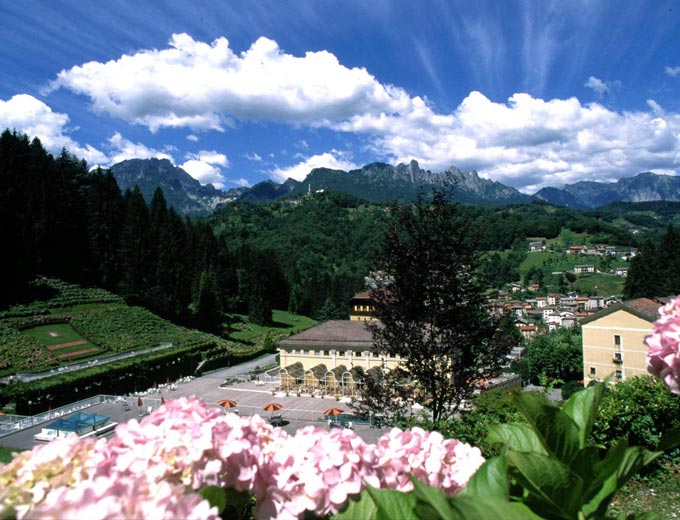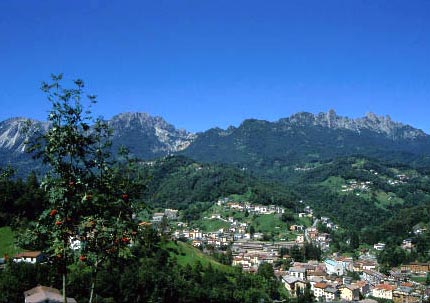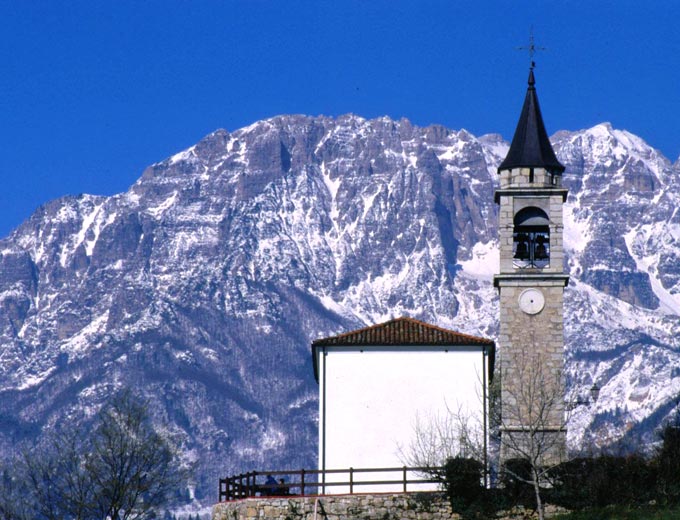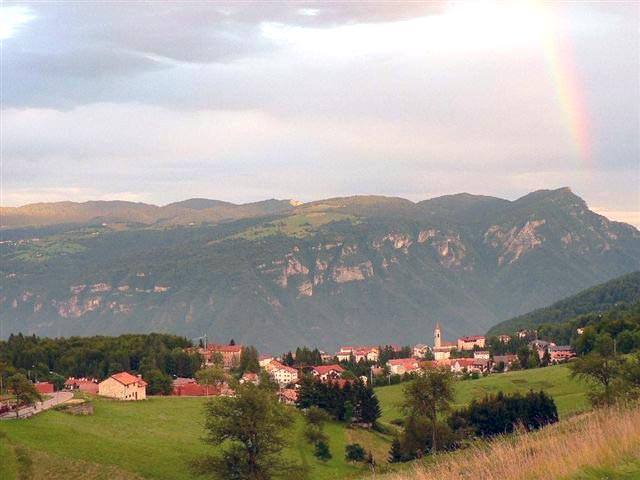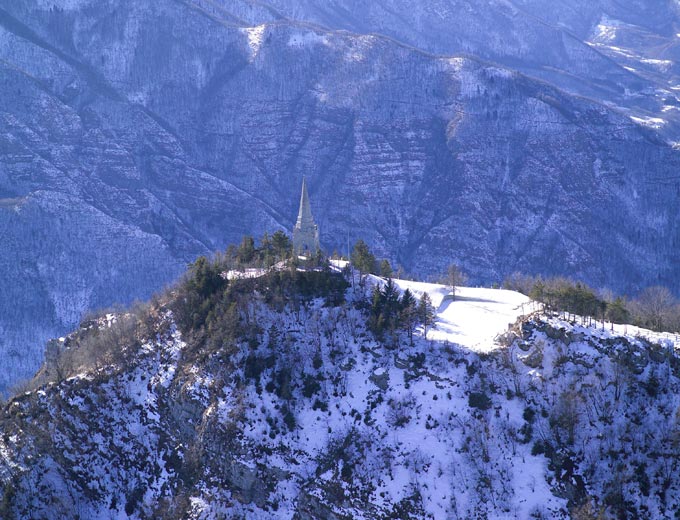The Leogra valley is located near Schio, the capital of industrial archaeology, and winds north-west, towards Pian delle Fugazze, at the foothill of Mount Pasubio, passing by the spurs of Mount Summano and Mount Novegno and the Small Dolomites, famous sceneries of the First World War. The area is bounded by the province of Treviso to the north, by the Valdastico and Posina municipalities to the east and by those of the Agno Valley to the west. It also borders to the south with the municipalities of the upper Vicentine plain, which includes Valli del Pasubio, Torrebelvicino, Monte di Mano, San Vito di Leguzzano, Santorso and Piovene Rocchette.
Numerous country districts still maintain many of the characteristics of the ancient rural life, even if it has been mixed with industrial culture. In addition to urban centres, the territory is characterised by the Leogra and Timonchio streams and four mounts (Sengio Alto, Pasubio, Novegno and Summano).
The most renowned products of the food and wine tradition of this land is the Marano corn and the wines produced by Cantina sociale della Val Leogra, in Malo: its top product is an interesting variety of Durello, aged 18 months under the castle of Schio. The liquour Gerolimino is another specialty, made by infusion of several essences.
Since the Middle Ages, the traditional rural economy has been accompanied by artisan activity, documented by the dense network of mills, sawmills and other facilities built along the banks of the Leogra stream and its deviation, the Roggia Maestra, an irrigation ditch dug in the first half of the 13th century between Schio and Pievebelvicino. The presence of the Roggia Maestra influenced the development of the urban centre of Schio and the economic life of its citizens. The Torrebelvicino-Pievebelvicino irrigation ditch dates back to the 20th century.
Water energy played an important part in the industrial development during the 19th century, because it was used to make the machines work. Similarly to other geographical piedmont situations in Northern Italy, the presence of water streams has always been of great importance, since industries kept seeking and using water energy even after relocating from the mountains to the plains and after the introduction of steam and electricity as energy sources.

Schio is the main attraction of the valley and the Upper Vicentine area: thanks to Alessandro Rossi’s knowledge on the factory system, it became the capital of wool industry in 1870. Different types of mills, sawmills, wool and industrial factories, as well as hydroelectric power plants and worker houses stand as proof of the ancient proto-industrial activities and the more recent ones in the Leogra Valley.
The so-called “Fabbrica Alta” (literally, “Tall Factory”) overlooks everything from its brick chimney stacks, a landmark and proof of the importance of the Schio industry at European level. To explore these landmarks means to retrace the network of relationships, behaviours, life styles and ideas that have created one of the most interesting industrial civilisation in the Veneto region.
Tourist Office
Comune di Schio - Ufficio di Promozione del Territorio
c/o Municipio, via F.lli Pasini 33 - Schio
Tel. +39 0445 691285
This email address is being protected from spambots. You need JavaScript enabled to view it.martedì e venerdì 9.00-13.00
lunedì, mercoledì e giovedì 9.00-13.00 / 14.30-17.30
https://www.visitschio.it/it
IN SUMMER
A happy combination of climate, spontaneous vegetation and scenic shapes allow those who love nature and exercise to find the ideal setting in Recoaro for a "healthy" stay, where hangglinding, mountain climbing, mountain-bike routes and many typesof walks and excursions can be enjoyed. The sourroundings of the villas offer guests of every age the haelthy coolness and magic of the woods, whereas up on high, the hazardous walls of the Small Dolomites are a challange for the most experiences climbers. Guided tours and excursions lead you live a holiday totally immerged in nature.
AND IN WINTER
Linked to the center of Recoaro by a modern cableway, and easy to reach also by car, the Recoaro Mille winter resorts extends over large areas from one thousand meters up, first showing its snowy gentle slopes for the less expert skiers, and then the steep slopes for experienced skiers. There are slopes, lifts and cableways for every skiiing enthusiast, accordin to taste and ability. And moreover, hanggliding, high altitude excursions and, obviously, cross-country skiing. All of this in breath-taking scenary where the snow, sun and mountains blend in unforgettable harmony.
"LE GUIDE" CENTRE
A group of professionals who take care of the organisation, management and development of tourist and teaching activities and appreciation of environmental resources on the Vicenza Prealps and in particular the Lower Dolomites. The Climbing Guides and the Environmental Hikes Guides take groups and single people on long climbing and hiking itineraries, on foot, mountain bike, skis and snowshoes all year round.
In the environmental education sector the on site activities such as day trips, research and naturalistic studies are complimented by alternative activities at the Piccole Dolomiti alla Guardia refuge, with the possibility of visiting naturalistic and historical museums and the area’s botanical gardens.
The "Le Guide" centre handles tourism breaks and all activities included in packages offered by the sector’s operators.
It also organises cultural activities relative to the mountains and the natural environment, climbing courses and lessons, free climbing, snowshoe excursions, guided climbs, hikes that last several days and have overnight stays in refuges or camps.
Amongst the services offered there is also slow mountain, which allows you to enjoy the mountains “slowly”, following relaxing itineraries with stops at refuges to enjoy typical gastronomical products and themed stops along the Great War or smugglers’ paths, searching for eagles or chamois, Large Trees or the Trassic of Recoaro.and everything else that these mountains can offer...
Information and Bookings: Environmental Hike Guide Sandri Sebastiano 368/7176118. Climbing Guide Asnicar Paolo 360/975597. Environmental Hike Guide Michele Franceschi 338 1592490 . Environmental Hike Guide Paolo Dani 347/0451032. Antonio De Toni 338/8532847
INFO www.csleguide.it.
FOR INFORMATION ABOUT MOUNTAIN DEWS OF THE LITTLE DOLOMITES: IAT Recoaro Terme Tel. 0445 75070.
INVITATION IN TONEZZA
Tonezza del Cimone is the perfect place for whoever loves long walkings, a quiet environment opposed to the present frenetic life in town, a splendid natural setting. Tonezza of fers an old-time atmosphere and friendly people. Ideal place for relaxing and interesting holiday.
THE CLIMATE, THE BEAUTY, THE NATURE, THE CALM ATMOSPHERE
The landscape offers a sequence of impressive mountains (Spitz, Tararo, Cimone and Campomolon) and enriched with their glaciers, which introduce to th e Altopiano with green terraces up to the Astico river.
FREE TIME
Modern sport-centers, 10 tennis fields, football fields, roller-skating pa ths, indoor swimming pool, riding-grounds, indoor bowling, open-air events, fishing. Amusement arcades, discos, cultural and popolar exhibitions, excursions and guided tours will make you e njoy your holiday!
THE ELEMENT OF MOUNTAIN BIKE
Tonezza a nd all the palces around are the right mountain bike's element, territory that lets itself know with a wide series of excursions to those who are keen on mountain bike, through no less than 12 different route, plunged into nature, traditions, history, artistic beauties, agrestic genuiness of places, structures and activites typical of this mountain and valley world full of beauty.
The start is always Tonezza del Cimone: from its top you find an uncountable number of asphalted and not asphalted steets, of cartways, of pathways that let you explore, "at man speed", the gret tableland and valley world. So once that you have left the health resort, you are ready to cycle through characteristic group of houses build on slopes, in the back side of prealpin pastures. And there where houses and you can admire a sorrounding senery made of summit sacred to memory overhanging typic wood and pastures of Fiorentini tableland, that has never changed through the years.
And now you can see sheperd's huts, alpin shelter and forts with all the historical material talking to us about the Second World War, meanwhile you can have a rest in one peaceful alpine church. You are now ready to le ave again to go towards the downvalley where Astico and Posina rivers touch th e villages. The routes seem to follow the two riverswhere the "fario and marmorata trouts" fin d their natural oasis; at this step our way leaves unwillingly this wonderful senery to lead us towards lakes "in miniature" plunged into the park's shadow where marvellouse "Antonio Fogazzaro's ville", runs of old castels and famous "Pieve" churches are hidden.
Old streets far away from city traffic climb up again mountain and valley: cycling through the green in a peaceful silence broken only by distant voices and sounds of nature, the effort lessens. And now before coming back to Tonezza del Cimone pathways going along mythical places of historical epos can be discovered again...always while cycling!
ENJOYMENT-TRADITIONS
The routes suggested offer you mountain bike pathways and the chance to make a "tour" full of suggestions to grasp with all your senses. As ypu have already noticed our "tour" is full of steps: they are not only the historical, cultural or artistic and natural one, but the noteworthfully ones, such as local gastronomy that keeps aro ma and tastes "of taht time" somewhere else completely forgotten. Here you find fresh and pressured cheese, the snow-white ricotta cheese, the mountin butter delicious mashrooms and friuts of the wood. Sausages are still prepared with the old and wellknown "Monks of Norcia's" recipe. Thousands of characteristics recipes make restaurants situated in this zone uncomparable and unique in their kind. These routes inside nature express the enjoyment for all those good things that will surely take your interest, one by one, walking or cycling all around Tonezza del Cimone.
SO AS NEVER TO FORGET: THE GREAT WAR FORTS
Overturned peaks, blood stained rocks, machine gun nests, trenches, rocky caves for cannons, and remains of forts: today these are the remains and testimonies that tell the story of the Great War fought on the Veneto/Trento front and are found in an area starting in the "Astico-Posina" to the Tonezza and Fiornentini Plateau. After the bombings in 1915 there was the Stafexpedition, provoked by the Austro-Hungarians in May 1916 and this territory became the last front for defending the Vicenza plains from the enemy. Attacks and counterattacks, painful attempts to escape from the tragedy, villages destroyed and human lives ruined: these were the effects of a war that will remain unforgettable to its protagonists and witnesses. Then, once silence returned to the high pastures, hillsides and mountain peaks hidden in the sky there were those who swore that there would be no more wars whilst the mourning for the victims, many of whom were nameless, was shown by lovingly burying the victims, united as brothers by death.
In front of the "Emperor’s forts" (Doss del Sommo, Sommo Alto, Cherle, Belvedere, Luserna, Verle, Pizzo di Vezzena) there were the “Kingdom’s sentinels ", more specifically the Italian forts of Campomolon, Cornolò, Casa Ratti, Punta Corbin, Campolongo, Verena. For those who wish to it is still possible to walk along History’s footpaths of the Eastern Italian old front and, in particular, the pre-Alpine mountains that overlook the Astico and Posina valleys where you can come across heavily damaged military ruins frequently destroyed by high calibre artilleries or blown up during the tragic Strafexpedition days.
Even if there is little more than walls left of Cornolò, between the val di Posina and Val di Rio Freddo, built to protect Arsiero, a visit to the Forte Campomolon ruins, situated at an altitude of 1853 m to contrast the forts in Folgaria, allows you to take in the architectural impressiveness of its structure and you will be able to glance at the four fortified domes through the battery block. At an altitude of 350m, in the mid Val d'Astico, and amongst an increasingly flourishing and wild vegetation lie the remains of the "Casa Ratti" fort, which once had three revolving domes and was armed with 3 149G cast iron and five machine guns surrounded by the rocky Tonezza Plateau border.
Moving upwards from the mountain village we arrive at Cimone, a sacred memorial. The woods do not completely hide all of the old bays, trenches or intricate network of tunnels. A crater created by an Austrian mine that exploded on the 23rd September 1916 is surrounded by the cusp of the ossuary that watches over the fallen whilst they rest. Your glance tends to fall towards horizons where the war is only a memory: the corno ducale of Caviojo and the Neutra peak, with its characteristic winding gallery, the majestic Priaforà, with its rocky caves, seem to watch over the valleys, where villages and hamlets are scattered and time stands still, and where drama and stories from our past are to be rediscovered through our memories and not to be told as myths.
(Giovanni Matteo Philosopher from
Vicenza in prima linea, Promotonezza)
NEW OBSERVATORY FOR THOSE WHO ARRIVE AT THE SPITZ PEAK
The Tonezza alpine group, led by the president Riccardo Pettinà, has happily concluded a task with Mount Spitz at centre stage: a solid support cippus capable of holding a round plaque with the names of the mountains visible from the peak of Spitz engraved (as many as 27 surrounding areas). The stone should have been transported to the site by a helicopter but, when this promise was not kept, it was brought up on foot by several of the Alpine corp. and volunteers.
Last year the Alpine corps also took care of the old and now dangerous mule track that went from Passo della Vena to the peak, at about 1700 metres.
THERE IS A PLACE...
...where pine and larch woods blend into endless pastures, a true paradise for marmots, deer, chamois and roe bucks;
a refuge for squirrels, grouse and eagles.
...where the past has left indelible traces, from the rocky edges of the Val d'Assa to the Bostel village, the ancient Cimbrian culture to the First World War.
...where fabulous, incredible flowers grow, from the Martagon lily to the Gentian, from Edelweiss to Sun Dew and the bog flytrap.
...where from 1310 to 1807 one of history’s first democracies was formed, under the name of the Spettabile Reggenza dei Sette Comuni.
...where even today there is a continuous exchange between Man and Nature, through cheese and honey production, herbal distilling, and mushroom and forest fruit picking
...where Gnomes, Elves and Fairies still live and where, as local legend has it, they spy on us from their dens plotting tricks and jokes to play.
...where you can find more than 500km of cross country ski tracks that become the largest and most complete network of mountain biking paths in the summer.
...where trekking, walks and horse riding still provide a taste of adventure, taking you to new places to discover.
...where the “national sports” are cross country skiing, downhill skiing, ice hockey, speed skating and ski jumping, not forgetting the summer sport of “grass” skiing.
...where there is one of Europe’s best 18 hole golf courses and where an airport with its runway at an altitude of 1000 metres is considered normal.
...where you can follow the impressive Ca del Sasso which, with 4,444 steps, is one of the longest flights of steps in the world and was built out of limestone between 1388 and 1392.
...where the sky is clear and you can see the stars and entire universe with your own eyes whilst lying on the grass or snow or using the four telescopes of the Italian Astrophysics Observatory.
...where the Gods once lived, on the Altaburg and Cima Dodici, on Monte Katz and in the Fren Valley. The Gods may still live there...





